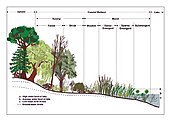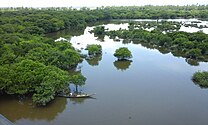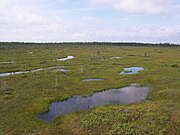
A | B | C | D | E | F | G | H | CH | I | J | K | L | M | N | O | P | Q | R | S | T | U | V | W | X | Y | Z | 0 | 1 | 2 | 3 | 4 | 5 | 6 | 7 | 8 | 9
A wetland is a distinct semi-aquatic ecosystem whose groundcovers are flooded or saturated in water, either permanently, for years or decades, or only seasonally for a shorter periods. Flooding results in oxygen-poor (anoxic) processes taking place, especially in the soils.[1] Wetlands form a transitional zone between waterbodies and dry lands, and are different from other terrestrial or aquatic ecosystems due to their vegetation's roots having adapted to oxygen-poor waterlogged soils.[2] They are considered among the most biologically diverse of all ecosystems, serving as habitats to a wide range of aquatic and semi-aquatic plants and animals, with often improved water quality by the plants removing excess nutrients such as nitrates and phosphates.
Wetlands exist on every continent.[3] The water in wetlands is either freshwater, brackish or saltwater.[2] The main wetland types are classified based on the dominant plants and the source of the water. For example, marshes are wetlands dominated by emergent herbaceous vegetation such as reeds, cattails and sedges. Swamps are dominated by woody vegetation such as trees and shrubs (although reed swamps in Europe are dominated by reeds, not trees). Mangals are wetlands with halophytic woody plants known as mangroves, which have evolved to tolerate salty water.
Examples of wetlands classified by the sources of water include tidal wetlands (where the water source is ocean tides), estuaries (water source is mixed tidal and river waters), floodplains (water source is excess water from overflowed rivers or lakes), and bogs and vernal ponds (water source is rainfall or meltwater).[1][4] Some wetlands have multiple types of plants and are fed by multiple sources of water, making them difficult to classify. The world's largest wetlands include the Amazon River basin, the West Siberian Plain,[5] the Pantanal in South America,[6] and the Sundarbans in the Ganges-Brahmaputra delta.[7]
Wetlands contribute many functions that benefit people. These are called ecosystem services and include for example water purification, stabilization of shorelines, storm protection and flood control. In addition, wetlands also process and condense carbon (in processes called carbon fixation and sequestration), and other nutrients and water pollutants. Wetlands can act as a sink or a source of carbon, depending on the specific wetland. If they function as a carbon sink, they can help with climate change mitigation. However, wetlands can also be a significant source of methane emissions due to anaerobic decomposition of soaked detritus, and some are also emitters of nitrous oxide.[8][9]
Methods exist for assessing wetland functions and wetland ecological health. These methods have contributed to wetland conservation by raising public awareness of the functions that wetlands can provide.[10] Constructed wetlands are a type of wetland that can treat wastewater and stormwater runoff. They may also play a role in water-sensitive urban design. Environmental degradation threatens wetlands more than any other ecosystem on Earth, according to the Millennium Ecosystem Assessment from 2005.[11]
Definitions and terminology
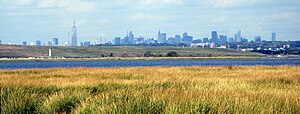
Technical definitions
A simplified definition of wetland is "an area of land that is usually saturated with water".[12] More precisely, wetlands are areas where "water covers the soil, or is present either at or near the surface of the soil all year or for varying periods of time during the year, including during the growing season".[13] A patch of land that develops pools of water after a rain storm would not necessarily be considered a "wetland", even though the land is wet. Wetlands have unique characteristics: they are generally distinguished from other water bodies or landforms based on their water level and on the types of plants that live within them. Specifically, wetlands are characterized as having a water table that stands at or near the land surface for a long enough period each year to support aquatic plants.[14][15]
A more concise definition is a community composed of hydric soil and hydrophytes.[1]
Wetlands have also been described as ecotones, providing a transition between dry land and water bodies.[16] Wetlands exist "...at the interface between truly terrestrial ecosystems and aquatic systems, making them inherently different from each other, yet highly dependent on both."[17]
In environmental decision-making, there are subsets of definitions that are agreed upon to make regulatory and policy decisions.
Under the Ramsar international wetland conservation treaty, wetlands are defined as follows:[18]
- Article 1.1: "...wetlands are areas of marsh, fen, peatland or water, whether natural or artificial, permanent or temporary, with water that is static or flowing, fresh, brackish or salt, including areas of marine water the depth of which at low tide does not exceed six meters."
- Article 2.1: " may incorporate riparian and coastal zones adjacent to the wetlands, and islands or bodies of marine water deeper than six meters at low tide lying within the wetlands."
An ecological definition of a wetland is "an ecosystem that arises when inundation by water produces soils dominated by anaerobic and aerobic processes, which, in turn, forces the biota, particularly rooted plants, to adapt to flooding".[1]
Sometimes a precise legal definition of a wetland is required. The definition used for regulation by the United States government is: 'The term "wetlands" means those areas that are inundated or saturated by surface or ground water at a frequency and duration to support, and that under normal circumstances do support, a prevalence of vegetation typically adapted for life in saturated soil conditions. Wetlands generally included swamps, marshes, bogs, and similar areas.'[19]
For each of these definitions and others, regardless of the purpose, hydrology is emphasized (shallow waters, water-logged soils). The soil characteristics and the plants and animals controlled by the wetland hydrology are often additional components of the definitions.[20]
Types

Wetlands can be tidal (inundated by tides) or non-tidal.[13] The water in wetlands is either freshwater, brackish, saline, or alkaline.[2] There are four main kinds of wetlands – marsh, swamp, bog, and fen (bogs and fens being types of peatlands or mires). Some experts also recognize wet meadows and aquatic ecosystems as additional wetland types.[1] Sub-types include mangrove forests, carrs, pocosins, floodplains,[1] peatlands, vernal pools, sinks, and many others.[21]
The following three groups are used within Australia to classify wetland by type: Marine and coastal zone wetlands, inland wetlands and human-made wetlands.[22] In the US, the best known classifications are the Cowardin classification system[23] and the hydrogeomorphic (HGM) classification system. The Cowardin system includes five main types of wetlands: marine (ocean-associated), estuarine (mixed ocean- and river-associated), riverine (within river channels), lacustrine (lake-associated) and palustrine (inland nontidal habitats).
Peatlands
Peatlands are a unique kind of wetland where lush plant growth and slow decay of dead plants (under anoxic conditions) results in organic peat accumulating; bogs, fens, and mires are different names for peatlands.
Wetland names
Variations of names for wetland systems:
Some wetlands have localized names unique to a region such as the prairie potholes of North America's northern plain, pocosins, Carolina bays and baygalls[24][25] of the Southeastern US, mallines of Argentina, Mediterranean seasonal ponds of Europe and California, turloughs of Ireland, billabongs of Australia, among many others.
Locations
By temperature zone
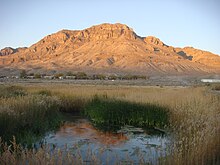
Wetlands are found throughout the world in different climates.[13] Temperatures vary greatly depending on the location of the wetland. Many of the world's wetlands are in the temperate zones, midway between the North or South Poles and the equator. In these zones, summers are warm and winters are cold, but temperatures are not extreme. In subtropical zone wetlands, such as along the Gulf of Mexico, average temperatures might be 11 °C (52 °F). Wetlands in the tropics are subjected to much higher temperatures for a large portion of the year. Temperatures for wetlands on the Arabian Peninsula can exceed 50 °C (122 °F) and these habitats would therefore be subject to rapid evaporation. In northeastern Siberia, which has a polar climate, wetland temperatures can be as low as −50 °C (−58 °F). Peatlands in arctic and subarctic regions insulate the permafrost, thus delaying or preventing its thawing during summer, as well as inducing its formation.[26]
By precipitation amount
The amount of precipitation a wetland receives varies widely according to its area. Wetlands in Wales, Scotland, and western Ireland typically receive about 1,500 mm (59 in) per year.[citation needed] In some places in Southeast Asia, where heavy rains occur, they can receive up to 10,000 mm (390 in).[citation needed] In some drier regions, wetlands exist where as little as 180 mm (7.1 in) precipitation occurs each year.[citation needed]
Temporal variation:[27]
- Perennial systems
- Seasonal systems
- Episodic (periodic or intermittent) systems
- Ephemeral (short-lived) systems
Surface flow may occur in some segments, with subsurface flow in other segments.
Processes
Wetlands vary widely due to local and regional differences in topography, hydrology, vegetation, and other factors, including human involvement. Other important factors include fertility, natural disturbance, competition, herbivory, burial and salinity.[1] When peat accumulates, bogs and fens arise.
Hydrology
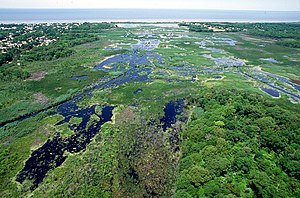
The most important factor producing wetlands is hydrology, or flooding. The duration of flooding or prolonged soil saturation by groundwater determines whether the resulting wetland has aquatic, marsh or swamp vegetation. Other important factors include soil fertility, natural disturbance, competition, herbivory, burial, and salinity.[1] When peat from dead plants accumulates, bogs and fens develop.
Wetland hydrology is associated with the spatial and temporal dispersion, flow, and physio-chemical attributes of surface and ground waters. Sources of hydrological flows into wetlands are predominantly precipitation, surface water (saltwater or freshwater), and groundwater. Water flows out of wetlands by evapotranspiration, surface flows and tides, and subsurface water outflow. Hydrodynamics (the movement of water through and from a wetland) affects hydro-periods (temporal fluctuations in water levels) by controlling the water balance and water storage within a wetland.[28]
Landscape characteristics control wetland hydrology and water chemistry. The O2 and CO2 concentrations of water depend upon temperature, atmospheric pressure and mixing with the air (from winds or water flows). Water chemistry within wetlands is determined by the pH, salinity, nutrients, conductivity, soil composition, hardness, and the sources of water. Water chemistry varies across landscapes and climatic regions. Wetlands are generally minerotrophic (waters contain dissolved materials from soils) with the exception of ombrotrophic bogs that are fed only by water from precipitation.
Because bogs receive most of their water from precipitation and humidity from the atmosphere, their water usually has low mineral ionic composition. In contrast, wetlands fed by groundwater or tides have a higher concentration of dissolved nutrients and minerals.
Fen peatlands receive water both from precipitation and ground water in varying amounts so their water chemistry ranges from acidic with low levels of dissolved minerals to alkaline with high accumulation of calcium and magnesium.[29]
Role of salinity
Salinity has a strong influence on wetland water chemistry, particularly in coastal wetlands[1][30] and in arid and semiarid regions with large precipitation deficits. Natural salinity is regulated by interactions between ground and surface water, which may be influenced by human activity.[31]
Soil
Carbon is the major nutrient cycled within wetlands. Most nutrients, such as sulfur, phosphorus, carbon, and nitrogen are found within the soil of wetlands. Anaerobic and aerobic respiration in the soil influences the nutrient cycling of carbon, hydrogen, oxygen, and nitrogen,[32] and the solubility of phosphorus[33] thus contributing to the chemical variations in its water. Wetlands with low pH and saline conductivity may reflect the presence of acid sulfates[34] and wetlands with average salinity levels can be heavily influenced by calcium or magnesium. Biogeochemical processes in wetlands are determined by soils with low redox potential.[35] Wetland soils are identified by redoxymorphic mottles (often from iron oxide rust) or low chroma intensity, as determined by the Munsell Color System.
Water chemistry
Due to the low dissolved oxygen (DO) content, and relatively low nutrient balance of wetland environments, most wetlands are very susceptible to alterations in water chemistry. Key factors that are assessed to determine water quality include:
- Major anion analysis: (HCO3−,Cl−,NO3−,SO42-)
- Major cation analysis (Ca2+, Mg2+, Na+, K+)
- pH
- Conductivity – conductivity increases with more dissolved ions in the water
- Turbidity
- Dissolved oxygen
- Temperature
- Total dissolved solids
- Gas emissions (carbon dioxide and methane; CO2 and CH4)
These chemical factors can be used to quantify wetland disturbances, and often provide information as to whether a wetland is fed by precipitation, surface water or groundwater, due to the different ion characteristics of the different water sources.[36] Wetlands are adept at impacting the water chemistry of streams or water bodies that interact with them, and can process ions that result from water pollution such as acid mine drainage or urban runoff.,[37][38]
Biota
The biota of a wetland system includes its plants (flora) and animals (fauna) and microbes (bacteria, fungi). The most important factor affecting the biota is the hydroperiod, or the duration of flooding.[1] Other important factors include fertility and salinity of the water or soils. The chemistry of water flowing into wetlands depends on the source of water, the geological material that it flows through[39] and the nutrients discharged from organic matter in the soils and plants at higher elevations.[40] Biota may vary within a wetland seasonally or in response to flood regimes.

Flora
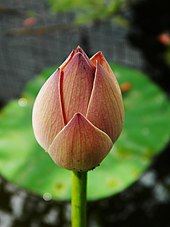
There are four main groups of hydrophytes that are found in wetland systems throughout the world.[41]
Submerged wetland vegetation can grow in saline and fresh-water conditions. Some species have underwater flowers, while others have long stems to allow the flowers to reach the surface.[42] Submerged species provide a food source for native fauna, habitat for invertebrates, and also possess filtration capabilities. Examples include seagrasses and eelgrass.
Floating water plants or floating vegetation are usually small, like those in the Lemnoideae subfamily (duckweeds). Emergent vegetation like the cattails (Typha spp.), sedges (Carex spp.) and arrow arum (Peltandra virginica) rise above the surface of the water.
When trees and shrubs comprise much of the plant cover in saturated soils, those areas in most cases are called swamps.[1] The upland boundary of swamps is determined partly by water levels. This can be affected by dams[43] Some swamps can be dominated by a single species, such as silver maple swamps around the Great Lakes.[44] Others, like those of the Amazon basin, have large numbers of different tree species.[45] Other examples include cypress (Taxodium) and mangrove swamps.
Fauna
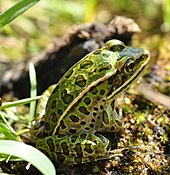
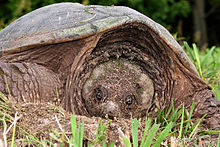
Many species of fish are highly dependent on wetland ecosystems.[46][47] Seventy-five percent of the United States' commercial fish and shellfish stocks depend solely on estuaries to survive.[48] Tropical fish species need mangroves for critical hatchery and nursery grounds and the coral reef system for food.
Amphibians such as frogs and salamanders need both terrestrial and aquatic habitats in which to reproduce and feed. Because amphibians often inhabit depressional wetlands like prairie potholes and Carolina bays, the connectivity among these isolated wetlands is an important control of regional populations.[49] While tadpoles feed on algae, adult frogs forage on insects. Frogs are sometimes used as an indicator of ecosystem health because their thin skin permits absorption of nutrients and toxins from the surrounding environment resulting in increased extinction rates in unfavorable and polluted environmental conditions.[50]
Reptiles such as snakes, lizards, turtles, alligators and crocodiles are common in wetlands of some regions. In freshwater wetlands of the Southeastern US, alligators are common and a freshwater species of crocodile occurs in South Florida. The Florida Everglades is the only place in the world where both crocodiles and alligators coexist.[51] The saltwater crocodile inhabits estuaries and mangroves and can be seen along the Eastern coastline of Australia.[52] Snapping turtles are one of the many kinds of turtles found in wetlands.[53]
Birds, particularly waterfowl and wading birds, use wetlands extensively.[54]
Mammals of wetlands[55] include numerous small and medium-sized species such as voles, bats,[56] muskrats[57] and platypus in addition to large herbivorous and apex predator species such as the beaver,[58] coypu, swamp rabbit, Florida panther,[59] and moose. Wetlands attract many mammals due to abundant seeds, berries, and other vegetation as food for herbivores, as well as abundant populations of invertebrates, small reptiles and amphibians as prey for predators.[60]
Invertebrates of wetlands include aquatic insects (such as dragonflies, aquatic bugs and beetles, midges, mosquitoes), crustaceans (such as crabs, crayfish, shrimps, microcrustaceans), mollusks (such as clams, mussels, snails), and worms (such as polychaetes, oligochaetes, leeches), among others. Invertebrates comprise more than half of the known animal species in wetlands, and are considered the primary food web link between plants and higher animals (such as fish and birds).[61] The low oxygen conditions in wetland water and their frequent flooding and drying (daily in tidal wetlands, seasonally in temporary ponds and floodplains) prevent many invertebrates from inhabiting wetlands, and thus the invertebrate fauna of wetlands is often less diverse than some other kinds of habitat (such as streams, coral reefs, and forests). Some wetland invertebrates thrive in habitats that lack predatory fish. Many insects only inhabit wetlands as aquatic immatures (nymphs, larvae) and the flying adults inhabit upland habitats, returning to the wetlands to lay eggs. For instance, a common hoverfly, Syritta pipiens, inhabits wetlands as larvae (maggots), living in wet, rotting organic matter; these insects then visit terrestrial flowers as adult flies.
Algae
Algae are diverse plant-like organisms that can vary in size, color, and shape. Algae occur naturally in habitats such as inland lakes, inter-tidal zones, and damp soil and provide a food source for many animals, including some invertebrates, fish, turtles, and frogs. There are several groups of algae:
- Phytoplankton are microscopic, free-floating algae. These algae are so tiny that on average, 50 of these lined up end-to-end would only measure one millimeter. Phytoplankton are the basis of the food web in many water bodies being responsible for much of the primary production using photosynthesis to fix carbon. Filamentous algae are long strands of algal cells that can form floating mats. Periphyton (or epiphyton) are algae that grow as surface biofilms on plants, wood, and other substrates.[62]
- Chara and Nitella algae are upright algae that look like a submerged plants with roots.[63]
Disturbances and human impacts
Wetlands, the functions and services they provide as well as their flora and fauna, can be affected by several types of disturbances.[64] The disturbances (sometimes termed stressors or alterations) can be human-associated or natural, direct or indirect, reversible or not, and isolated or cumulative. Disturbances exceed the levels or patterns normally found within wetlands of a particular class in a particular region. Predominant disturbances of wetlands include:[65][66]
- Enrichment/eutrophication
- Organic loading and reduced dissolved oxygen
- Contaminant toxicity
- Acidification
- Salinization
- Sedimentation
- Altered solar input (turbidity/shade)
- Vegetation removal
- Thermal alteration
- Drying/aridification
- Inundation/flooding
- Habitat fragmentation
- Other human impacts
Disturbances can be further categorized as follows:
- Minor disturbance: Stress that maintains ecosystem integrity.[67]
- Moderate disturbance: Ecosystem integrity is damaged but can recover in time without assistance.[67]
- Impairment or severe disturbance: Human intervention may be needed in order for ecosystem to recover.[67]
Just a few of the many sources of these disturbances include:[68]
- Drainage
- Development
- Over-grazing Zdroj:https://en.wikipedia.org?pojem=Wetlands
Text je dostupný za podmienok Creative Commons Attribution/Share-Alike License 3.0 Unported; prípadne za ďalších podmienok. Podrobnejšie informácie nájdete na stránke Podmienky použitia.
Antropológia
Aplikované vedy
Bibliometria
Dejiny vedy
Encyklopédie
Filozofia vedy
Forenzné vedy
Humanitné vedy
Knižničná veda
Kryogenika
Kryptológia
Kulturológia
Literárna veda
Medzidisciplinárne oblasti
Metódy kvantitatívnej analýzy
Metavedy
Metodika
Text je dostupný za podmienok Creative
Commons Attribution/Share-Alike License 3.0 Unported; prípadne za ďalších
podmienok.
Podrobnejšie informácie nájdete na stránke Podmienky
použitia.
www.astronomia.sk | www.biologia.sk | www.botanika.sk | www.dejiny.sk | www.economy.sk | www.elektrotechnika.sk | www.estetika.sk | www.farmakologia.sk | www.filozofia.sk | Fyzika | www.futurologia.sk | www.genetika.sk | www.chemia.sk | www.lingvistika.sk | www.politologia.sk | www.psychologia.sk | www.sexuologia.sk | www.sociologia.sk | www.veda.sk I www.zoologia.sk

